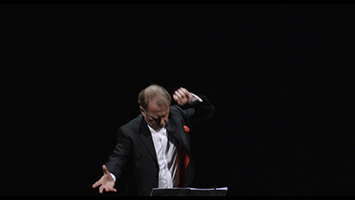MartinArgyroglo180405-098_s.jpg)
MartinArgyroglo180405-098_s.jpg)
形態如何生成
Where Shapes Come From
2016,雙頻錄像,8分55秒
Two-channel video, 8'55"
半導體 (露絲.賈爾曼+喬.格哈特)
Semiconductor (Ruth JARMAN + Joe GERHARDT)
露絲.賈爾曼 英國 1973年生英國,現於英國布萊頓生活及工作
喬.格哈特 英國 1972年生於英國,現於英國布萊頓生活及工作
Ruth JARMAN UK 1973 born in UK, now living and working in Brighton, UK
Joe GERHARDT UK 1972 born in UK, now living and working in Brighton, UK
《形態如何生成》由英國藝術創作雙人組「半導體」兩位成員露絲.賈爾曼和喬.格哈特於2016年的共同創作。雙頻道的作品交錯著礦物科學實驗室中研究者的口述、實驗室工作日常與電腦動畫,作品深入原子的世界觀中,重考了科學如何去演繹及敘說我們所觀察到的外在、自然與物質生態。正如同古代煉金術士的名言「如其在上,如其在下」,作品展現了微觀宇宙與宏觀宇宙之間的連結,也在微觀宇宙中連接起我們與物質世界之間的關係。
露絲和喬將礦物實驗的過程、敘說描繪的語言、物質的生成樣貌以一段礦物研究者的生活日常影像來演示。作品中,研究者做著每日實驗室的日常工作,切割隕石樣本並說著自原子相鍵結至結晶成礦物的化學過程與規則。從鍵結、群聚到成形,背後的組織一切的化學平衡方程式,看不見而群聚起的晶格結構與形態,最終以我們能夠看見的礦石型態被感知到。而一段來自馬里亞納海溝中所採集到的地震原始資料,在實驗室中被轉換成了聲音訊號並以此控制電腦產生動畫。動畫交錯在實驗室生活影像中。三組聲音與影像巧妙交織訴說著我們是如何藉由科學與技術的發展補捉人所看不見的物質結構並行演繹及歸納邏輯,而這之中都有著人類意志介入的痕跡與角度。
我們對外在的經驗或理解方式都是值得再去被重新思考的。從另個角度來看,《形態如何生成?》更宏觀但也歡娛地指出了科學、科技的發展提供了人類一個普世的語言去理解及分析所居處的物質世界。然則,物質世界的發生與變化常常是一瞬的,科學能提出並再現一個物質模型及其理解模式,然而科學與技術的敘述也僅是那一瞬之中的某個切入角度的思考與敘述。
Where Shapes Come From is a collaborative work by the 2-man British group “Semiconductor”, Ruth Jarman and Joe Gerhardt, in 2016. The two-channel video work is a mix of the oral account of a scientist from rock and mineral laboratory, the routine works in the laboratory, and the computer generated animations. Venturing into the world view in atomic scale, the work rediscovers how science demonstrates and narrates the exterior as well as the nature and ecology of matter we have observed. Just like the saying of the ancient alchemists, “As above, so below”, the work manifests the connection between the micro-universe and macro-universe, and connects us to the world of matter in the micro-universe.
Ruth Jarman and Joe Gerhardt demonstrate the process of mineral experiment, the language to narrate and portray, and the formed appearance of matter with videos of mineral researcher’s daily routines. In the work, the researcher carries out the daily routines in the laboratory, cutting up sample of meteorites while explaining the chemical processes and rules from the bonding of atoms to the crystallization into minerals. From bonding, clustering and forming to the chemical equation that organizes everything underneath as well as the clustering lattice structure and shape invisible to the eye, and finally the ultimate form of mineral we can see are detected. The raw seismic data collected from the Mariana Trench are converted into sound signals in the laboratory, which control the computer generated animations. The animations are mixed with the images of laboratory. The three sets of sounds and images delicately intertwine with one another, telling how we capture the invisible structure of matter and perform deduction and induction, among all of which lie the traces and perspectives of human will.
It is worthwhile to reconsider our experience of the outer world and ways of our understanding. Seeing from another angle, How Shapes Come From points out the development of science and technology offers Mankind a universal language to comprehend and analyze the world of matter they live in a broader and more entertaining manner. Nevertheless, the happening as well as alternation in the world of matter is short and swift. Science may offer and represent a model of matter and a pattern to understand. Yet, the description by science and technology is no more than one thinking and description of certain angle of that swift instant.







